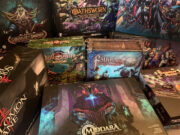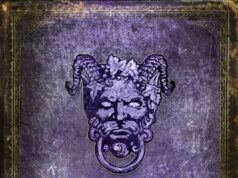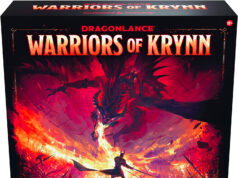 Over here at the Board Game Quest bunker, it’s not often we get to sample and review games with a deep history. Most of the current crop of review copies that get dropped at our door will go back 10 years at the most, and those games are updated or deluxe editions of games that still commonly hit the table. This is a rare moment indeed because the history of our next game goes back to 1986 and has just as many misty beginnings as Dungeons & Dragons.
Over here at the Board Game Quest bunker, it’s not often we get to sample and review games with a deep history. Most of the current crop of review copies that get dropped at our door will go back 10 years at the most, and those games are updated or deluxe editions of games that still commonly hit the table. This is a rare moment indeed because the history of our next game goes back to 1986 and has just as many misty beginnings as Dungeons & Dragons.
There have been a few tabletop sports games over the years, but none have rivaled Blood Bowl for popularity. Indeed, when the game was first released (1986), it was a basic game with cardboard standees for players which eventually (unsurprisingly even today) were replaced with Citadel metal miniatures. The second edition (1988) refined the rules and play area, but it wouldn’t be until the third edition (1994) that Blood Bowl more completely resembles the game of today. Since 1994, the game had a long hibernation except for supporting articles until Games Workshop released a new edition in 2016 which was the reinvigoration of the game as a dedicated product line. At the same time, Games Workshop also produced Blitz Bowl, meant as a shorter and easier introduction to Blood Bowl mechanisms. The product being reviewed today, Blood Bowl: Second Season Edition, is the refinement and evolution of the 2016 product and the culmination of 24 years of fan dedication and encouragement.
Shedding all that buildup, Blood Bowl is a fantasy creature and rugby+American football miniatures game for 2 players. Each match takes about 60 to 90 minutes to play. HOWEVER, Blood Bowl really shines (and is somewhat meant to be played) as a league play game (4 teams minimum). These could be multiple teams played by the same player or individual players. The more teams there are in a league, obviously, the more games (matches) are played and the longer the season is.
Gameplay Overview:
To set up a match, players will have prepared two opposing teams of up to 16 figures (positional players). Eleven of those players will be placed on the field to start with each player required to place a certain number along the middle line of a field that resembles an American football field. Each team has an End Zone which they defend against the opposing team which is attempting to drive the ball.
The teams are composed of players from a mixture of fantasy creatures. These come from the Games Workshop fantasy mythos and usually represent an affinity for one type of creature or another. For example, the Skaven rat-people have their own team as do the Wood Elves, Humans, and varieties of Undead. With each creature type come certain abilities expected for the species qualities. Wood Elf teams tend to be good at passing the ball, Ork teams are great at bashing and grinding an opponent, and Undead teams get some regeneration. Even within that formula, there are lots of areas for customization as players gain experience and can acquire new skills and upgrades to ability scores used to resolve actions in the game.

For a match, players play an alternating 8 turns during a half, and, obviously, there are 2 halves in a game. During each one of these 16 turns, a player will be attempting to move players into position to either make blocks, pass, and/or generally run the ball without opposition into the opponent’s End Zone (a Touchdown). Doing so scores 1 point. In general, at the end of a match, Blood Bowl scores tend to mimic a soccer match.
The real twist to this preceding formula comes in how each turn is played. Blood Bowl is essentially a game of risk management. Most actions executed in the game involve some chance of failure. If that action fails, the player’s turn ends immediately, and it is now the opponent’s turn. For example, if a figure attempts a block (trying to push or knockdown) against another figure, the specialized “Block Dice” are rolled. If that result comes up with a Skull, the figure performing the block (not the defender) is knocked down. This failure immediately causes a turnover and now the other player can take actions.
This simple recipe results in a playstyle where players are cautious about which figures to activate and in which order. Riskier moves tend to go later in activation order and so an elaborate combination of figure actions can result in just the right series of events to get movement space open for the ball carrier to speed into the End Zone. With elf teams, in general, this involves succeeding on an accurate pass attempt, an accurate catch attempt, and having enough defenders around the receiver to stave off any opposition. Since a player’s turn also ends after each individual figure has taken an action, it can happen that after a turn, a player’s figures are in a more vulnerable position than when they began their play.

Players with an extreme allergic reaction to randomness might be bailing from the rest of this article, but Blood Bowl does have a modest antihistamine. Since there is so much randomness in the game, players are also given a number of reroll attempts which they purchase before the match. A player might have 4 reroll attempts which they can decide to use over the course of each half. If they use up all their rerolls early in a half, they must accept the outcome of any actions from there on out.
Apart from this very, very high-level view of play, Blood Bowl’s league play is where much of the strategizing and decision making occurs. Since players will gain experience from certain actions in the game, each player can acquire new skills to help mitigate the risk of actions. For example, the “Pass” skill allows a player to get a free reroll on a failed Pass attempt. The essential “Block” skill mitigates one of the negative results from the Block dice.
Besides player management, as a team coach/owner, players can also hire various supporting resources for their team. One thing that hasn’t been mentioned yet is that not only can players be knocked down during an action, but the resulting brutality of a knock down could result in a player being knocked unconscious, suffering a major injury, or, worse, killed. To help out, a coach can hire an Apothecary to fix up players during a match. They could also hire Cheerleaders or Assistant Coaches to aid some events in the game. Given the decades of the game’s development, many of these additional options have evolved over the years but all add some element of risk mitigation for each match played.
The final ingredient that should be mentioned is that Blood Bowl teams also feature a Team Value which can vary depending on which players (figures) are on the team including Star Players who can be hired for various roles. Star Players go beyond the rules for normal player stats and can add exceptional playmaking ability to a team. In addition, since figures can gain experience and become extremely valuable, coaches will want to protect them from injury or death on the field. This makes a league of Blood Bowl have the potential for great upsets if a key positional player dies. As Team Value changes, different options, known as Inducements, will be available to them to mitigate the disparity in ability for a match. These are temporary aids to make sure the weaker team will have some offset to the advantage of better players or resources of the stronger team.
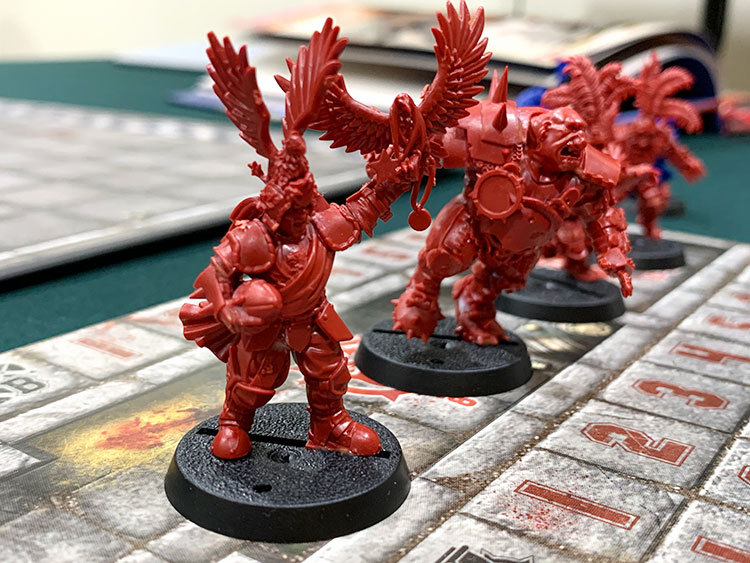
Game Experience:
Now, it is all well and simple to lay out how Blood Bowl is played, even if at the very abstract, but to properly evaluate the game there are three types of players that come to mind: those who have no experience with Blood Bowl, those who love miniatures games but may not know the Blood Bowl ecosystem, and experienced fans who know what the game is all about and just want to know if the new version is any good. This review will aim at all the above in three sections below.
New Players
Getting into a miniatures game like Blood Bowl is similar to making the investment into a game much like the X-Wing Miniatures Game but not exactly the same as even heavier titles like Warhammer 40K. Just to get into the game, the product reviewed here comes with a fantastic hardcover book of rules and two basic teams: Imperials and Black Orks. This is enough for what is called an Exhibition match, a simple one-off game to experience the rules of the game and understand how the mechanisms work. The two teams are well balanced but also have enough uniqueness of their own.
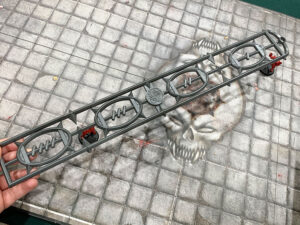
Once players have grown beyond these teams, the purchase of 2 additional teams makes the most sense, and then players can experience a small league. If a group of 4 players is interested in trying out a league, this is the best place to start with each player purchasing their own team. It’s immensely fun to pour over team position stats to make decisions about which team to start with and how to develop that team over a season. Each team costs $40 (currently) and there are 21 to choose from. With the core set here costing $140, a group of 4 players could spend between $220 and $300 to have 4 individual teams.
If it’s not apparent already, Blood Bowl is a game that takes some investment, but it is incredibly rewarding with players ready to dig into the action. The type of players that seem to enjoy Blood Bowl the most are those who love playing fantasy sports in the real world or those who love to experience the up and down drama of a team over a season. In league play, Blood Bowl replicates this wonderfully. The angst of seeing a Star Player fall or the thrill and appropriate cheering after a perfectly executed play, especially after some risky rolls, are unique moments in gaming. Much like real sports, Blood Bowl seems to create memories, and that is what has kept the game alive even after Games Workshop took a hiatus from development for 20 years.

Another note for new players is to be wary of some growing and learning pains. Blood Bowl is not the type of game where everything can be understood after a single experience. The nuances of how all the rules work together will be grokked only by experienced coaches. Even someone with a year of experience playing 2 or 3 leagues can seem inexperienced against players who have lived playing the game for a decade. This shouldn’t dissuade players from getting into the game, rather, if players love exploring a game, Blood Bowl has such an enormous amount of depth to discover. The whole system rewards continued investment without requiring as much investment as more lifestyle-focused miniatures games.
If players are still hesitant, or may not have the experience for building the plastic models, the easy decision is to try the game Blitz Bowl. It’s a much, much more refined version of what Blood Bowl is with the same types of decisions. It comes at a much lower price and the miniatures are dramatically easier to assemble. This is also a better game to bring out with families and young-ish kids since each game is meant to be much more standalone.
Miniatures Fans
The main focus for fans of existing miniatures games is how much the quality of the miniatures add to play and the paintability/customization options provided. On both fronts, Games Workshop has really improved with this version of the game. The complexity of the miniatures is on par with any of their other game lines but, for most teams, scaled down to an individual model that can sometimes be customized due to included separate parts.

Like many miniatures games, Blood Bowl rewards continued play and investment so there are hundreds of unique models to paint and a vast system of rules to learn. The stats do not go as deep as a game like Warhammer 40K, but the sports theme integration makes up for it. The arc of a season and the storytelling between games is what keeps players coming back again and again. While tournaments are not going to be as common as Warhammer 40K, the ecosystem is friendlier to newer players since many of the concepts draw right from American football and/or rugby. The core box with Imperials and Black Orks feature unique and creative models with just enough options for customization. As a single box purchase, it offers a great introduction to the rewards of continued investment.
Experienced Blood Bowl Fans
It is to be expected that long time Blood Bowl fans really just want to know what the differences are between this version and the 2016 or earlier versions. This reviewer feels that since Board Game Quest covers board games as a whole, these fans aren’t coming to us for the details but might perhaps be gamers who have tried Blood Bowl in the past and are interested to see how the game has evolved.

The last edition this reviewer played with was the 3rd edition of the Living Rulebook. Having played a fair bit online as well, the experience was enough to know most skills and what league play is all about. The best article online to see specific differences between this and the 2016 edition can be found here. This gives an overview of all changes such as Player Characteristics, Inducements, Passing/Catching, and the tiers of teams.
In summary, the changes focus on streamlining play, making plays more flexible, and encouraging the parity of teams with varied Team Value. It could be assumed that there are a lot of new players to Blood Bowl matched with experienced Blood Bowl players and that these changes are necessary. In reality, the changes make for more enjoyable games because they serve to keep experienced teams engaged and focused on overcoming the bonuses of the lesser team.
Overall, the game is still Blood Bowl. New teams, adjustments, and refinements of existing teams with more alternate species all add options and clarifications. Nothing in the changes are worthy of gathering torches to storm the Games Workshop fortress. If anything, the changes are more inclusive and focused on creating memorable moments, higher quality, and games with talking about. That’s just plain ol’ good product management.
Final Thoughts:
If readers haven’t guessed by now, Blood Bowl Second Season is a triumph in this reviewer’s eyes. This edition’s rules changes, hardcover book, tiering of teams, and overall embrace of the game shows that Games Workshop didn’t see the 2016 version as a one-off production to placate rabid fans. The system as a whole is improved and while the miniatures may still seem expensive, they’re some of the best in the hobby. The game too comes off as complex and a bit obscure, but players, especially new players, are very gently eased into the game from the included well-produced rules. There is also an enormous wealth of resources online to aid in learning and supporting league play. More than at any other time (and with the exception of some Kickstarter titles), Blood Bowl is a premier miniatures game that surpasses what gamers have come to expect.
Final Score: 5 Stars – An incredible, enjoyable miniatures game that delivers what a marriage of fantasy and sports is meant to be.
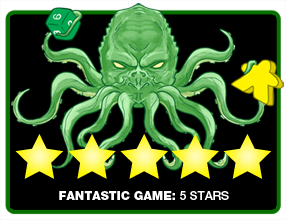 Hits:
Hits:
• Complex and challenging play
• Extremely well developed, customizable miniatures
• Depth of play with a league
Misses:
• Price




